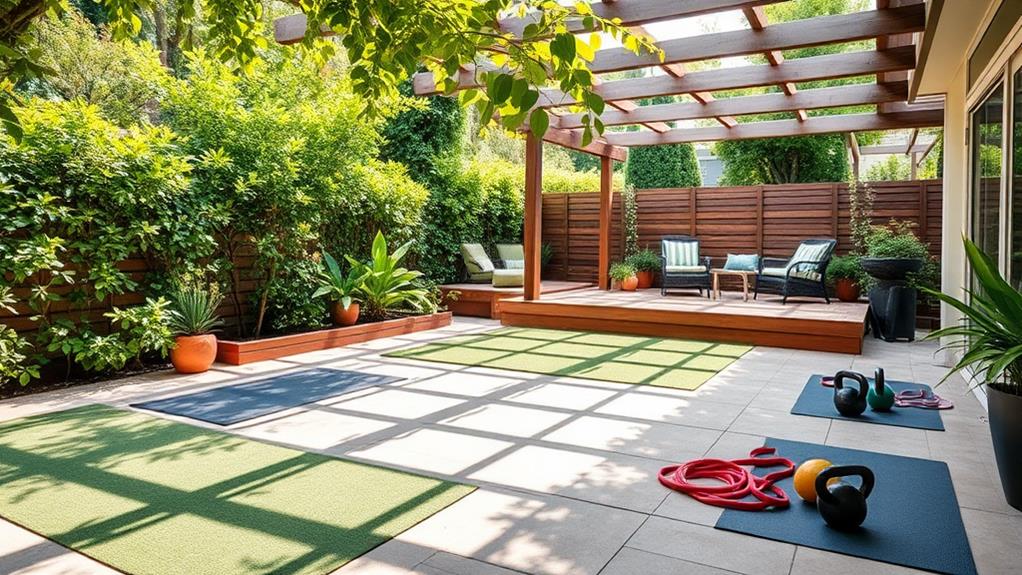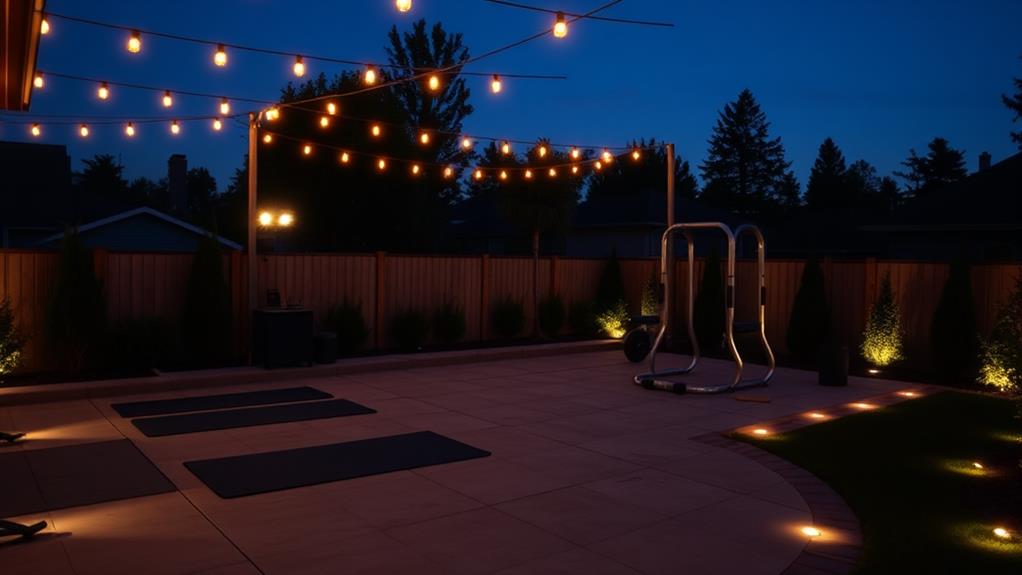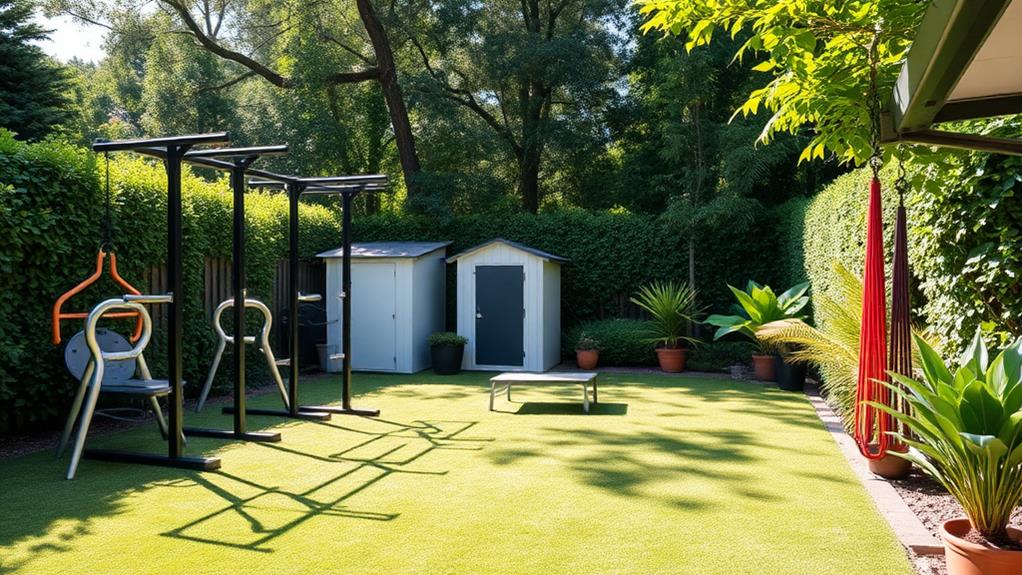Creating an open-air workout space combines the benefits of exercise with the refreshing elements of nature. Start by assessing your outdoor area, considering sunlight, privacy, and available utilities. Choose weather-resistant equipment made from durable materials like powder-coated steel. Install appropriate flooring, such as rubber or artificial turf, for safety and comfort. Incorporate natural elements like boulders or tree stumps for functional strength training. Ensure proper lighting for evening workouts and provide storage solutions for fitness gear. By carefully planning your outdoor fitness area, you can design a versatile and inviting space that enhances your exercise routine and overall well-being.
Assessing Your Outdoor Space

Before embarking on any outdoor fitness renovation project, a thorough assessment of your available space is crucial. Begin by measuring the dimensions of your outdoor area, noting any existing structures, trees, or landscaping features. Consider the terrain, including slopes, uneven surfaces, and drainage patterns that may impact your renovation plans.
Evaluate the amount of sunlight and shade in different parts of your outdoor space throughout the day. This information will help determine optimal locations for various fitness equipment and activities. Additionally, assess the privacy level of your outdoor area and consider any potential noise concerns for both you and your neighbors.
Take stock of existing utilities, such as water and electrical connections, which may be useful for incorporating lighting or water features into your fitness space. Analyze the soil composition and stability to ensure proper foundation for any equipment or structures you plan to install.
Choosing Weather-Resistant Exercise Equipment
Three key factors should guide your selection of weather-resistant exercise equipment for your outdoor fitness area: durability, functionality, and aesthetics. Durability is paramount, as outdoor equipment must withstand various weather conditions. Look for materials like powder-coated steel, galvanized metal, or high-density polyethylene (HDPE) that resist rust, corrosion, and UV damage.
Functionality is crucial for ensuring your equipment serves its intended purpose. Consider versatile pieces that allow for multiple exercises, such as multi-station gym systems or adjustable benches. Ensure the equipment caters to your fitness goals and accommodates different skill levels.
Aesthetics play a role in creating an inviting outdoor fitness space. Choose equipment that complements your landscape design and home exterior. Many manufacturers offer customizable color options to match your preferences.
When selecting specific items, consider weather-resistant versions of traditional gym equipment like pull-up bars, resistance bands, and weight benches. Outdoor-specific options such as balance beams, climbing walls, and stationary bikes designed for outdoor use are also excellent choices. Remember to invest in proper anchoring systems to ensure stability and safety, especially for larger equipment pieces.
Flooring Options for Outdoor Workouts

Selecting the right flooring for your outdoor workout area is crucial for safety, performance, and longevity. Several options are available, each with distinct advantages and considerations.
Rubber flooring is a popular choice due to its shock-absorbing properties, durability, and low maintenance requirements. It provides excellent traction and can withstand heavy equipment. Interlocking rubber tiles offer easy installation and replacement of damaged sections.
Artificial turf is another viable option, offering a natural look with minimal upkeep. It provides a soft surface for bodyweight exercises and can be installed with shock-absorbing underlayment for added safety.
Concrete is a cost-effective and long-lasting solution, ideal for strength training and cardio equipment. However, it can be hard on joints and may require the addition of rubber mats in high-impact areas.
Composite decking offers a sleek appearance and is resistant to moisture, mold, and UV rays. It provides a stable surface for various exercises but may become slippery when wet.
For a more natural feel, consider wood decking or pavers. These materials offer aesthetic appeal but may require more maintenance and have shorter lifespans compared to synthetic options.
Incorporating Natural Elements
Integrating natural elements into your outdoor fitness area can enhance both the aesthetic appeal and the overall workout experience. Consider incorporating large boulders or tree stumps for functional strength training exercises like step-ups, box jumps, or seated exercises. These natural features can double as seating areas during rest periods.
Utilize existing trees or install sturdy poles to create anchor points for suspension training systems or resistance bands. This allows for a wide range of bodyweight exercises without the need for bulky equipment.
Incorporate a sand pit for plyometric exercises, improving stability and adding resistance to movements.
Create a rock garden or gravel path for barefoot walking or running, which can help strengthen foot muscles and improve balance. Install a water feature, such as a small fountain or stream, to provide a calming backdrop and natural cooling effect during workouts.
Consider planting native vegetation around the fitness area to create natural wind barriers, provide shade, and attract local wildlife. This not only enhances the environment but also contributes to a more immersive outdoor experience. Lastly, use natural materials like wood or stone for any necessary structures, such as pull-up bars or workout stations, to maintain a cohesive, nature-inspired aesthetic.
Lighting for Evening Exercises

Proper lighting is essential for creating a safe and inviting outdoor fitness space that can be used after sunset. Strategic illumination not only extends the usable hours of your fitness area but also enhances safety and ambiance. When planning your lighting scheme, consider a combination of ambient, task, and accent lighting to achieve optimal results.
For overall illumination, install weatherproof LED floodlights or overhead fixtures that provide broad coverage without harsh glare. These should be positioned to eliminate shadows and dark spots. Task lighting is crucial for specific exercise areas, such as weight stations or yoga platforms. Use adjustable spotlights or bollard lights to focus illumination where it's needed most.
Accent lighting can add depth and visual interest to your outdoor fitness space. Path lights along walkways improve navigation, while uplights on trees or architectural features create a pleasant atmosphere. For a touch of versatility, consider smart lighting systems that allow you to adjust brightness and color temperature to suit different activities or times of day. Remember to use energy-efficient, durable fixtures designed for outdoor use to ensure longevity and minimize maintenance requirements.
Storage Solutions for Fitness Gear
With your outdoor fitness space well-lit, the next consideration is keeping it organized and clutter-free. Implementing effective storage solutions for fitness gear is crucial to maintain a functional and inviting workout area. Consider installing weather-resistant cabinets or lockers along a wall or fence to house smaller equipment like resistance bands, yoga mats, and hand weights.
For larger items such as medicine balls, kettlebells, and dumbbells, opt for sturdy, outdoor-rated shelving units or racks. These can be freestanding or mounted to a wall, depending on your space constraints. Incorporate a pegboard system for hanging jump ropes, suspension trainers, and other accessories, maximizing vertical space usage.
If your outdoor fitness area includes cardio equipment like stationary bikes or treadmills, invest in high-quality, waterproof covers to protect them from the elements when not in use. For yoga or stretching mats, consider wall-mounted roll-up storage solutions that keep them easily accessible yet out of the way.
Lastly, don't forget about small storage boxes or bins for items like towels, water bottles, and personal belongings. Choose containers with secure lids to keep contents dry and pest-free.
Creating Shade and Shelter

Shade and shelter are essential components of any well-designed outdoor fitness area. They protect users from harsh sunlight, rain, and other weather elements, ensuring comfort and safety during workouts. To create effective shade and shelter, consider installing pergolas, gazebos, or retractable awnings over key exercise zones.
For a more budget-friendly option, strategically placed shade sails can provide ample coverage while adding a modern aesthetic to the space. Trees and large shrubs can offer natural shade and contribute to a pleasant environment. When planning shelter structures, ensure they are sturdy enough to withstand local weather conditions and are properly anchored.
Incorporate weather-resistant materials like treated wood, metal, or high-quality plastics for longevity. Consider integrating UV-resistant polycarbonate panels or tempered glass in roofing to allow natural light while blocking harmful rays. For added functionality, install fans or misters within sheltered areas to enhance air circulation and cooling during hot weather. Proper drainage systems should be implemented to prevent water accumulation. Lastly, ensure that shade and shelter solutions do not obstruct sightlines or compromise the overall layout of the fitness area.
Safety Considerations
Safety is paramount when designing and implementing an outdoor fitness area. Careful consideration must be given to surface materials, equipment placement, and potential hazards. Choose slip-resistant, shock-absorbing surfaces like rubber tiles or artificial turf to minimize injury risks from falls. Ensure proper spacing between equipment pieces to prevent collisions and allow for safe movement.
Install adequate lighting for early morning or evening workouts, and consider motion-sensor options for energy efficiency. Secure all equipment firmly to the ground and perform regular maintenance checks to identify loose bolts, rust, or wear. Implement clear signage with usage instructions and safety guidelines for each piece of equipment.
Weather-related safety is crucial. Provide proper drainage to prevent water accumulation and install lightning protection systems in open areas. Consider wind exposure when placing tall structures or equipment. Include a first-aid station and emergency contact information in a visible location.
For child safety, separate adult and children's fitness areas, and use age-appropriate equipment. Install safety fencing around the perimeter to prevent unsupervised access and keep pets away from the workout zone. Lastly, consult local regulations and obtain necessary permits to ensure compliance with safety standards.
Maintenance and Longevity Tips

To ensure the longevity of your outdoor fitness area, regular maintenance is essential. Implement a routine cleaning schedule, removing debris, leaves, and dirt from equipment surfaces and the surrounding area. Regularly inspect all equipment for signs of wear, rust, or damage, addressing issues promptly to prevent further deterioration.
Apply weather-resistant coatings to metal surfaces annually to protect against rust and corrosion. For wooden elements, use appropriate sealants or stains to guard against moisture and UV damage. Lubricate moving parts of equipment as recommended by manufacturers to maintain smooth operation and prevent excessive wear.
Check and tighten all bolts, screws, and fasteners periodically to ensure equipment stability and safety. Replace worn or damaged components immediately, using only manufacturer-approved parts. Maintain proper drainage in the fitness area to prevent water accumulation, which can lead to equipment damage and create slip hazards.
Consider installing protective covers for sensitive equipment during harsh weather conditions. Trim nearby vegetation regularly to prevent encroachment and reduce moisture retention. By following these maintenance practices, you can significantly extend the lifespan of your outdoor fitness area and ensure a safe, enjoyable workout environment for years to come.
Frequently Asked Questions
How Much Does It Typically Cost to Create an Outdoor Fitness Space?
The cost of creating an outdoor fitness space typically ranges from $5,000 to $50,000, depending on factors such as size, equipment quality, and landscaping requirements. Basic setups can be more affordable, while elaborate designs increase expenses significantly.
Are There Noise Restrictions for Outdoor Workouts in Residential Areas?
Surprisingly, 65% of neighborhoods have noise ordinances. Residential areas often impose noise restrictions on outdoor activities, including workouts. These regulations typically limit noise levels and specify quiet hours to maintain community harmony and respect neighbors' peace.
Can Outdoor Fitness Spaces Increase Property Value?
Outdoor fitness spaces can potentially increase property value by enhancing curb appeal and offering desirable amenities. Well-designed outdoor workout areas may attract health-conscious buyers, making the property more competitive in the real estate market.
How Do I Protect My Outdoor Fitness Area From Pests and Wildlife?
To protect your outdoor fitness area from pests and wildlife, implement regular pest control measures, use sealed storage for equipment, install proper lighting, maintain cleanliness, and consider installing physical barriers like fencing or netting where appropriate.
Are There Eco-Friendly Options for Building an Outdoor Fitness Space?
A green oasis of strength emerges. Eco-friendly outdoor fitness spaces incorporate sustainable materials like recycled rubber flooring, bamboo equipment, and solar-powered lighting. Natural landscaping and permeable surfaces reduce environmental impact while promoting harmony between exercise and nature.
Conclusion
As the sun dips below the horizon, a transformed backyard emerges—a beacon of health and vitality. Weather-resistant equipment gleams, natural elements intertwine with purposeful design, and strategically placed lighting beckons. This carefully crafted outdoor fitness haven stands ready to inspire and challenge, regardless of the elements. With proper maintenance and attention to safety, this open-air gymnasium will endure, offering a sustainable solution for those seeking to merge the great outdoors with their fitness journey.

